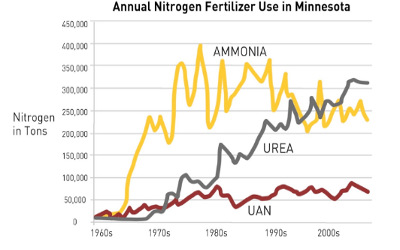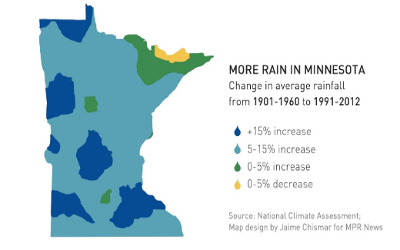By: Fabian Fernandez, Extension nutrient management specialist
Urea is an increasingly popular nitrogen fertilizer source in Minnesota. With some retailers switching away from anhydrous ammonia, there is an increased emphasis on urea use in certain areas of the state. Around half of farmers in the state now use urea as their main nitrogen source, and it is the dominant source in northwest Minnesota.

In the southwest, south-central and west-central areas of the state, about 45 percent of nitrogen is applied in the fall, 50 percent in the spring, and 5 percent at sidedress. Applying nitrogen in the fall can be tempting for several reasons, including generally lower fertilizer cost and greater supply, better distribution of labor and equipment, typically drier soil conditions to support field traffic, and time availability.
Urea applied in the fall has been included as a Best Management Practice in Minnesota because the potential for nitrate loss has typically been low in the drier regions of the state, including southwest, west-central, and northwest Minnesota. However, the prevailing weather conditions that support the use of fall urea as a BMP are not the same as we are experiencing now.

In recent years, due in large part to wetter-than-normal springs, fall urea applications have resulted in reduced yields. Weather patterns in Minnesota are becoming wetter in early spring and drier later in the growing season, and the state is experiencing warmer temperatures in the fall and winter. These two factors can lead to greater nitrogen loss than in the past.
A recent University of Minnesota research project in south-central Minnesota, funded by the Minnesota Corn Growers Association, showed that fall applications of urea should not be done due to greater nitrate loss in tile drainage. From 2013 to 2015, nitrate loss at our field trials was, on average, 38 percent higher in tile drainage water compared to spring urea. While grain yield differences between time of application were inconsistent across years, fall urea had the greatest risk of yield reduction. In 2013, fall-applied urea reduced yield by 22 bushels per acre across our field trials compared to spring application.
We started a new study in the fall of 2015 to evaluate the feasibility of fall urea applications across several regions of the state. This project, funded by the Agricultural Fertilizer Research and Education Council, AFREC, focuses on the northwest, west-central, southwest, and south-central parts of the state.
Preliminary results from the first three growing seasons indicate that spring applications of urea are more advantageous than fall applications across Minnesota, even at sites where the potential for nitrogen loss is relatively low. Averaged across all locations and years, we observed that, compared to spring, a fall application takes around 37 more pounds of nitrogen per acre to achieve the economic optimum nitrogen rate, and the yield at that optimum is 6 fewer bushels per acre; a lose-lose situation for the farmer with fall applications.

This has been especially true for the south-central part of the state, as we have seen in the past. For the southwest and west-central parts of the state, there is a strong emerging trend for better performance with spring applications. In the northwest, while there is some hint of improved performance in the spring, many of the sites had very little response to nitrogen, making it more difficult to establish the effect of timing of application.
Compared with urea, using a nitrification inhibitor, a polymer-coated urea, or banding instead of broadcasting and incorporating the application has produced inconsistent results. So, using any of these approaches may not be sufficient to make fall urea applications more effective.
The bottom line is that recent weather conditions suggest stronger than before that fall urea application is not, and has not been, a recommended practice for south-central Minnesota. For the other regions, because of lower yields and increased potential for nitrification and nitrogen loss of fall-applied urea, we suggest applying urea in the spring. If you feel the need to apply nitrogen in the fall, anhydrous ammonia with a nitrification inhibitor is a better option.
Source : umn.edu